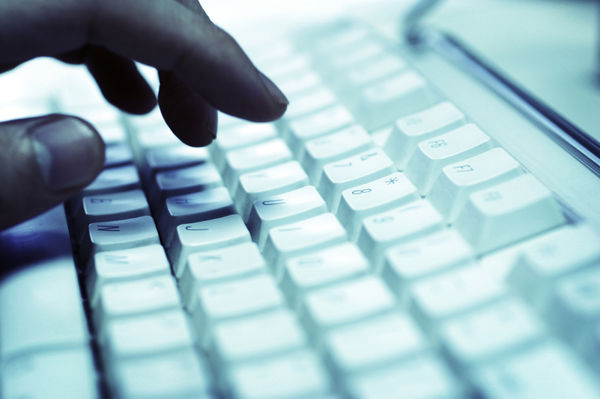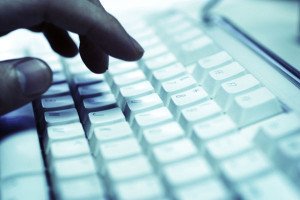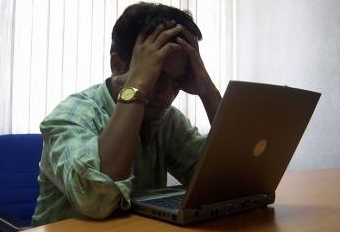Advanced user. “Confident PC user” video course for a beginner
Do you still think that the computer is not for you and it is difficult to master the skills of working with it? Typing text quickly without looking at the keyboard, setting up, optimizing the system, repairing a computer seems only within the power of a master. But that's not true. This article will help you stop being a novice user and join the ranks of experienced PC users.
The tips in this article will help you become a more experienced computer user. And over time, you will understand that in 99% of cases of computer breakdown, you can not call a technician, but can handle it yourself. I hope you have already read the article, otherwise it will no longer be useful to you, because you intend to become a professional.
Learn to type quickly

The ten-finger touch method allows you to type texts on a computer at high speed without taking your eyes off the monitor. Having learned such a big task, you will become more productive, any work and correspondence will be completed many times faster. And from the outside they will not look at you as a “teapot”.
Today there are many simulators, both on Internet sites and individual programs for Windows. With the help of such simulators, it is easier to learn to touch type using the ten-finger method. By practicing a little every day you can learn in a few weeks. At first it will seem difficult, but with persistent training, after two or three weeks you will notice that you practically do not look at the keyboard when typing. We have a special article dedicated to tips that will help you get started. Increase your productivity!
Learn PC repair and setup
 Learn to fix errors and malfunctions on your computer yourself, articles from this site will help you with this. Also, in addition to OKompach, there are many useful sites through which you will learn how to optimize your system, set up your computer and the Internet, repair your laptop, and much more.
Learn to fix errors and malfunctions on your computer yourself, articles from this site will help you with this. Also, in addition to OKompach, there are many useful sites through which you will learn how to optimize your system, set up your computer and the Internet, repair your laptop, and much more.
Here are just some of the sites that will be useful to you:
Become an experienced Internet user
 Nowadays without World Wide Web no way. And, of course, most of the time we spend at the computer is spent on the Internet. Be sure to read the articles in the “Security” section on this site, for example, about how to properly protect yourself, your loved ones and your computer from threats and leaks of personal information.
Nowadays without World Wide Web no way. And, of course, most of the time we spend at the computer is spent on the Internet. Be sure to read the articles in the “Security” section on this site, for example, about how to properly protect yourself, your loved ones and your computer from threats and leaks of personal information.
Study interesting material from the IT industry
 Read Hi-Tech news. Interesting articles from Wikipedia on computers and high technologies. Explore the insides of the computer. Watch films about hackers and computer geniuses. Read about operating systems, programs, computer components, learn from each other, etc. and so on. All this will help you be superior to any inexperienced user's kettle.
Read Hi-Tech news. Interesting articles from Wikipedia on computers and high technologies. Explore the insides of the computer. Watch films about hackers and computer geniuses. Read about operating systems, programs, computer components, learn from each other, etc. and so on. All this will help you be superior to any inexperienced user's kettle.
Make friends with your keyboard and mouse
 Much has already been said, here again I would like to say that hot keys allow you to perform work in a particular program many times faster. Once you remember the basic ones, you can use them in other programs. This allows you not only to reduce work time, but also emphasize your punctuality, knowledge and confidence in your PC. Also, hotkeys are very convenient when working with, and even. Be sure to learn the basic combinations, it greatly increases productivity.
Much has already been said, here again I would like to say that hot keys allow you to perform work in a particular program many times faster. Once you remember the basic ones, you can use them in other programs. This allows you not only to reduce work time, but also emphasize your punctuality, knowledge and confidence in your PC. Also, hotkeys are very convenient when working with, and even. Be sure to learn the basic combinations, it greatly increases productivity.
After reading the article, you will understand that you have not fully used a computer manipulator before. But in vain. Some functions are very, very useful in operation.
Master complex programs
![]() Learn to use complex programs, such as Photoshop, 3Dmax, CorelDraw. You can find a bunch on the Internet useful information on this topic, entire lessons and manuals on Photoshop, video editing, etc. Start with the simplest things and gradually learn from there. After a while you will notice how much you have “grown”.
Learn to use complex programs, such as Photoshop, 3Dmax, CorelDraw. You can find a bunch on the Internet useful information on this topic, entire lessons and manuals on Photoshop, video editing, etc. Start with the simplest things and gradually learn from there. After a while you will notice how much you have “grown”.
Learn programming languages
 And what? Why not try it. Programming, to be honest, is a very exciting activity. What if, after trying it once, you like it and seriously decide to take up coding? First, try such online training services as Codeacademy and Code Combat; if you have a tablet or smartphone on Android, download the Lightbot game; by the way, it is also available for iOS. Well, very soon it will appear on OKompah.ru detailed guide how to learn to program, where to start and how best to learn. So subscribe to site updates by e-mail, join in in social networks and wait for the next articles.
And what? Why not try it. Programming, to be honest, is a very exciting activity. What if, after trying it once, you like it and seriously decide to take up coding? First, try such online training services as Codeacademy and Code Combat; if you have a tablet or smartphone on Android, download the Lightbot game; by the way, it is also available for iOS. Well, very soon it will appear on OKompah.ru detailed guide how to learn to program, where to start and how best to learn. So subscribe to site updates by e-mail, join in in social networks and wait for the next articles.
How to keep your OS running for a long time
It is no secret that, some time after installation, the Windows XP operating system begins to work worse: various errors appear, the system often freezes, slows down, etc.
Such phenomena cause a lot of inconvenience, and often the user solves this problem with the usual reinstalling Windows. Some reinstall the system once or twice a year, others almost every month.
I was like that myself until I started to adhere to elementary rules on keeping the OS in working order. This allowed me not to reinstall Windows for more than 2 years.
Tip #1: Keep your desk clean.
Many people, when downloading files from the Internet or copying from removable media(CD, flash drive) save everything to the desktop. Over time, the number of such files grows - this circumstance can lead to the computer starting to slow down.
This happens because the contents of the desktop are stored in a special folder on system disk.
Thus, by saving files to the desktop, we reduce the amount of free space on the system disk, which is necessary for normal operation of the system.
I had a case when on a friend’s computer I found a 1.5 GB folder on the desktop! After deleting this folder, the computer began to work normally.
Therefore, regularly delete large files from your desktop or, better yet, do not store large files on your desktop.
You can view the volume of the desktop folder on the system drive at the following path:
OS section:\Documents and Settings\account name\Desktop
Tip #2: Empty your trash regularly.
The second common mistake many users make is forgetting to empty the trash.
Over time, a lot of “garbage” accumulates in it, which also leads to a decrease in free space on the hard drive, including the system drive.
Therefore, if there is little space on your hard drive, empty the recycle bin. Perhaps even this will be enough.
One of my friends deleted games and programs by simply deleting folders and files (we will discuss this error below). So, when I came to him to figure out why the new and powerful computer It started to slow down terribly and discovered that there was very little space on the system disk.
Reason: it was in the cart more than 2 GB remote games. After cleaning the recycle bin, the computer stopped slowing down.
Tip #3: Remove unused programs.
If you have many programs installed, and some of them you use very rarely, for example, once every six months, then remove these programs.
Why fill the disk with programs that are not used?
Important! You need to remove programs only through the “Add or Remove Programs Wizard”, which is located in the panel windows control, or through special utilities to remove programs.
If you uninstall programs by simply deleting a folder, this will lead to even more errors in the system.
For example, a friend deleted Nero by simply erasing the folder. After that, he could neither burn discs, nor install another version of Nero, nor correctly remove (via the wizard) the “remnants” of the existing one.
I had to use two computer cleaning programs to properly remove the "residues" of this version of Nero.
Tip #4: Delete temporary files.
Temporary files are files that are created when you install or use certain programs.
Some of these files are deleted after the installation of the program is completed or after the program is uninstalled, but some files still remain.
Typically these files are stored on the system drive in folders called “temp”.
After a certain period it accumulates a large number of temporary files, and their total volume can reach several GB, which also affects the performance of the computer.
To remove temporary files, you can use Disk Cleanup, which is built into Windows XP.
To do this, in the disk properties, click the “Disk Cleanup” button and in the list provided, select “Temporary files” to delete.
But this method does not work very well, and to delete temporary files it is better to use other programs, for example, etc.
These programs are designed not only to delete temporary files, but also to optimize the operating system as a whole.
Tip #5: Clean your registry.
A registry is a database that stores information about equipment, installed programs, program and system settings. Windows uses this information in its work.
As is the case with temporary files, after programs are deleted, information about these programs remains in the registry.
Over time, a large amount of it accumulates, which also affects the performance of the computer.
Therefore, it is necessary to regularly clean the registry from errors.
The same programs for optimizing the system will help us with this: TuneUp Utilities, Ace Utilites, CCleaner and so on.
Tip #6: Defragment your hard drive.
On a hard drive, files are stored in disk sectors (clusters). When saving a file, the system writes parts of the file to free sectors of the disk.
Thus, the file turns out to be fragmented, i.e. consists of several fragments. Moreover, one part of the file can be located in sectors located at the beginning of the disk, and the other part can be in sectors located at the end of the hard disk.
This leads to additional costs for searching all parts of the file being opened, and, accordingly, the time for various operations on files increases.
Therefore, it is advisable to perform defragmentation at least once every six months, the result of which will be that all parts of the file will be stored in adjacent sectors, which means that the search time for these parts will be significantly reduced.
To defragment a disk, you can use the built-in Windows program defragmentation.
To start, go to “disk properties” – “service” tab – “Run defragmentation”.
You can also use a defragmenter from other manufacturers, for example, PerfectDisk, TuneUp Utilities.
We have considered the main issues regarding keeping Windows in working order.
Below I will provide additional tips to help you avoid loss important files in case of OS failure, and also quickly restore the system, even if it stops loading.
Tip #7: Do not keep important files on the system drive.
To store documents, disc projects, working files of other programs, especially photos, music and films, create folders on a different, non-system partition.
In case of problems with the OS - failures in loading, operation, violation of the integrity of the partition - the likelihood of losing all your files will be much lower.
Even if the OS cannot be restored, then you can simply format the partition and install the system and programs again. In this case, files on other disk partitions will not be affected.
A friend had a case: he recorded photographs of a 1.5 year old child on DVD. After HDD broke, and the DVD fell into the child's hands. Photos are missing...
Tip #8: Do it backup system partition.
In another way, this operation is called creating an image of the system partition.
What is it for?
Having made an image of the system partition, in case of OS failures, or if the system does not work at all, you can deploy it from the image.
Thus, you will not need to reinstall the system, drivers, programs, etc. All this will be restored from the image within 10-20 minutes.
And keep the second image on your hard drive. You need to periodically, for example, once every six months, copy the system partition from an already installed system, drivers and programs.
To create an image of a partition, you can use the following programs: Acronis True Image, Nero BackItUp and so on.
As you can see, there are no secrets to working correctly with a computer. Follow these rules and your computer will work well for a long time.
If you read the article and were unable to put these tips into practice, then I recommend paying attention to the video course “Confident PC User,” in which some of these issues are discussed in the form of visual video instructions.
Hello to all dummies, users and non-hackers!) You bought a computer, they connected you to the Internet. And what are you doing there? Stay on social networks, watch videos on YouTube, play standard games Windows? Do you want to use the capabilities of your PC and the Internet to the fullest? Are you tired of constantly calling a technician, friends, acquaintances to service your computer, who charge impressive amounts of money for 10 minutes of work? Then learn how to use a PC yourself.
We know how to teach you to work with a PC quickly and efficiently, in just 10 days, without attending expensive courses, without tutoring services, without a huge amount of printing educational material. We present to you a training video course “Confident PC user”- this is the most effective method studying PCs that do not require large financial investments, which will save your time and effort.
If you don’t know how to install the Operating System, reinstall Word, install printer drivers; If you have difficulty replacing a video adapter, RAM, cooler, cartridge; If you don’t know how to burn a disc, how to work with archiving files, how to divide a hard drive into partitions, how to install and configure an application Software; If you constantly have to call specialists, then this course is definitely for you!
Video training is one of the most effective and efficient methods of acquiring knowledge and skills. After all, your virtual mentor can repeat the information you need at any time an unlimited number of times.
The course is divided into three discs:
- Installation of OS Windows XP. You will learn about two types of OS installation, consider the basic operations in the BIOS.
- Installing drivers, programs and working with them. Learn to install and configure drivers, utilities and programs. Learn how to restore your system and prepare for installing Windows XP.
- Working in Windows XP. This disc will tell you how to work with a computer not only for novice users, but also for those who are more experienced in this area, but still do not know how to maintain their PC, change various settings, etc.
10 days – and you are an experienced PC user!
After completing the training, you will be able to independently maintain your computer and troubleshoot problems that arise. You will no longer ask for help to reinstall the system, drivers, or write information to disk. You will confidently work in well-known programs that will greatly facilitate your work and save a lot of time.

Confident PC User is a unique working guide to using a PC. This is a system of knowledge that is maximally short term will teach you how to master the computer. You will learn to resolve a wide variety of computer problems that may arise during its operation.
In addition, you will receive 3 useful gifts for the video course, which will give you access to a closed forum. From them you will learn how to install two OS on one computer, and learn how to manage hard drive partitions!!!
Thank you for being with us. Have your say about the course in the comments. Good luck!
